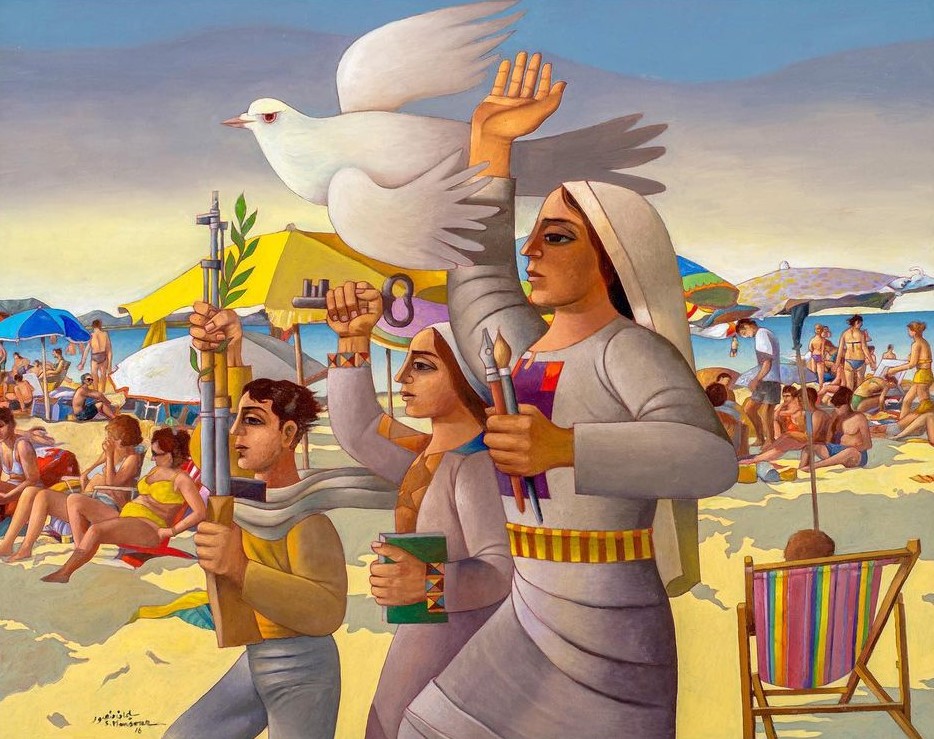As Sliman Mansour, his work is connected to the land
We know there was a lot to be angry about before October 2023.
Haifa Massacre (1937), Jerusalem Massacre (1937), Haifa Massacre (1938), Balad al-Sheikh Massacre (1939), Haifa Massacre (1939), Haifa Massacre (1947), Akka Massacre (1947), Abbasiya Massacre (1947), Balad al-Sheikh Massacre (1947), Al-Khisas Massacre (1947), Bab al-Amud Massacre (1947), Jerusalem Massacre (1947), Sheikh Bureikh Massacre (1947), Jaffa Massacre (1948), Al Tantura Massacre (1948), Deir Yasin Massacre (1948), Al-Saraya Massacre (1948), The Semiramis Massacre (1948), Jerusalem Massacre (1948), Al-Saraya Al-Arabeya Massacre (1948), Lydda Massacre (1948), Ramla Massacre (1948), Yazur Massacre (1948), Haifa Massacre (1948), Tabra Tulkarem Massacre (1948), Sa’sa Massacre (1948), Abu Kabir Massacre (1948), Cairo Train Massacre (1948), Nasir al-Din Massacre (1948), Tiberias Massacre (1948), Ayn al-Zaytoun Massacre (1948), Safed Massacre (1948), Beit Dara Massacre (1948), Al-Husayniyaa Massacre (1948), Khan Yunis Massacre (1956), Kafr Qasim Massacre (1956), Jersusalem Massacre (1967), Tel al-Zaatar Massacre (1976), Sabra and Shatila Massacre (1982), Al Aqsa Massacre (1990), Ibrahimi Mosque Massacre (1994),
I came to earth in 1995. A human. And there is much to be angry about now. Dear world, do you know what Massacre means?
Gaza Massacre (2008 – 9), Gaza Massacre (2012), Gaza Massacre (2014), Gaza Massacre (2018 – 19)
It is brutal slaughter. This world is outrageous. Anger is being passed down generations. New humans are grieving and rightfully outraged. As the GUPS 1970 poster aptly puts, the struggle for justice is still young.
Genocide of People of Palestine (2021 –
They are dropping bombs on tents, creating 30-feet-deep craters. Parents identify the children by weighing in grams in trash bags. Yet the children of Palestine manage to mix the orange color with water to make ice pops and smile. What happened to human beings?
When Israel (Occupied Palestine) struck UNRWA schools in Gaza, and reports of Palestinian artists being murdered started coming in, I started searching on Instagram to see how creative minds sustain their ability to imagine a better world under Genocide. I found out about Sliman Mansour in my search window.
Peace is possible when each one of us is considered a human being and ‘has the same rights’. ,he says in his recent interview with Al Jazeera.
What happened to us? What happened to all children are our children? Witnessing the young torn apart limb by limb.
Sliman’s A Witness on Tel Al-Zaatar, Hill of Thyme, opens our window to witness a woman with hollow eyes standing in front of destruction, playing the flute. The massacre of 1500 – 3000 people.
Woman with Jerusalem, Camel of Hardships, and the Holy Family in an Olive Grove bleeds with deep sorrow. Does the art industry have nothing to say? These are not commodities for display cases after Palestine is free. He is showing the truth, the actual reality, that Palestine was not an empty lot before Israel, that these are people; humans that breathe, live, accomplish, care and dream; humans with centuries-old cultures and traditions intertwined with the roots of equally old olive trees. Does the art industry not have enough to act with urgency? You can not have their stories in your museums without standing with the people now. You can not call yourself an artist when you can not resist the destruction of life.
Born in 1947, in Birzeit, Palestine, Mansour is an artist of the Intifada. His life is tightly knit together with the transformations of Palestine’s national movements. His collective New Visions in response to the first intifada drew from his childhood memories of working with his grandmother, a beekeeper. In 1987, they used natural materials to boycott Israeli art supplies. So when I thought about material that I could use, mud was the first thing that came to my mind. After a while, once I started making figures, I realized that the mud also reflects the human fate with the cracks, people waiting to disappear, fall down and go away.
A seed takes on the full weight of the earth – the blood in the soil, the winds gusting through forests, the water from the sky, the heat from the planet’s core – before it germinates and shoots up from the ground.
Sliman became the first Palestinian student at Israel’s Betzalel Art Academy (Occupied Palestine) after the six-day war in 1967. Then, he became the first president of the Palestine Artists’ Association in 1978.
Forty-three years back, he, along with his father-in-law and brother-in-law were arrested by Israeli authorities while taking pictures of Qalandia (a Palestinian village). He was photographing the villagers to draw later. Art reflects the soul of a certain time.
As Sliman, his work is connected to the land. There is loss, and hope, and a dream of return. Like the soil itself, his identity is constantly displaced, fragmented, and bombarded to wipe out from existence, yet it is still alive, ingrained in the scapes of Palestine, no matter the decimation and distances.
When you go to Sliman’s profile, he is wearing a subtle smile in his display picture. So many decades have passed under occupation that you should know the smile of a Palestinian artist becomes an ocean; it is keeping memories, it is keeping the collective emotions of his people enduring unforgivable struggles, till the time comes when the waves can be set free to crash against the shores of a freed Palestine, from the river to the sea.
Written by Lariab Ahmad
Image: The Sea is Mine, Sliman Mansour, aqueous print on archival canson rag paper, all copyrights are retained by the artist 2024.
